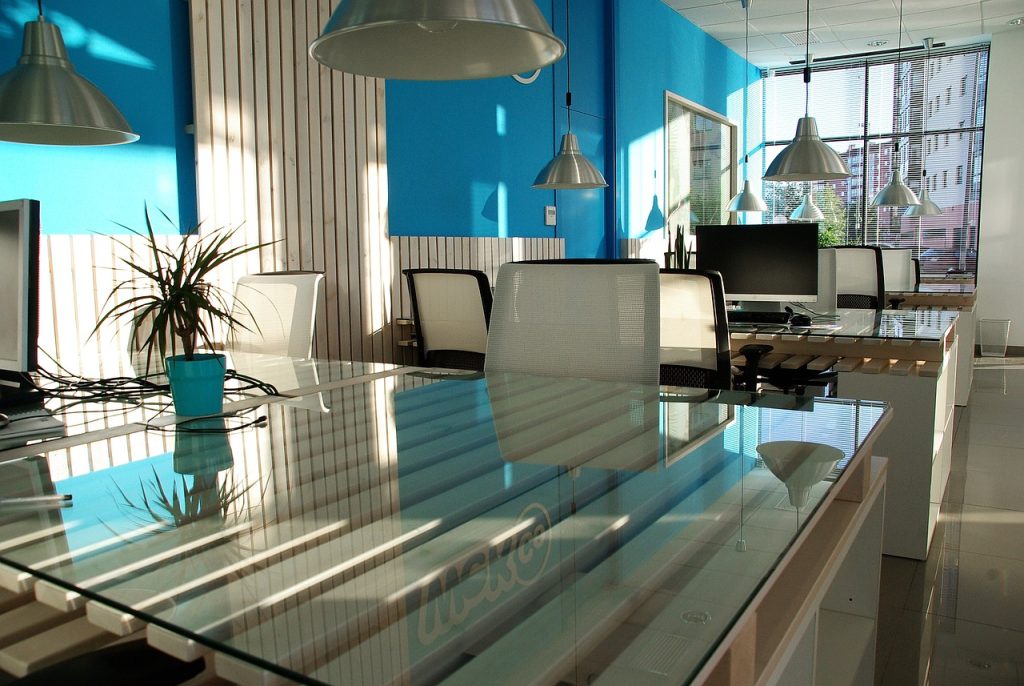Remote Work and the Future of Office Spaces

In recent years, the landscape of work has undergone a profound transformation, and at the heart of this evolution is the rise of remote work. As organizations adapt to this paradigm shift, the future of office spaces is being redefined. In this blog post, we’ll explore the impact of remote work on traditional office settings and delve into how the future of office spaces is shaping up to meet the changing needs of a dynamic workforce.
Table of Contents
The Remote Work Revolution
The COVID-19 pandemic has undeniably acted as a powerful catalyst for the widespread adoption of remote work across industries. Companies that were previously reluctant to embrace this model found themselves thrust into a new reality, compelling them to quickly pivot their operations and workflows. This rapid shift has not only forced organizations to re-evaluate the effectiveness of remote work but also prompted a fundamental reconsideration of the role of physical office spaces in the future.
In the wake of this global transformation, businesses are now recognizing that remote work can offer significant benefits beyond just crisis management. The shift has sparked a rethinking of traditional notions around productivity, collaboration, and employee well-being. As a result, many companies are beginning to view remote work not just as a temporary solution but as a strategic opportunity to leverage talent from anywhere while offering employees greater flexibility and autonomy. This paradigm shift is challenging long-held assumptions about how work should be structured and executed, leading to innovative approaches in defining what constitutes an effective and conducive work environment in today’s digital age.
Suggested Article: Small office space? No problems, we have the solution for you!
Hybrid Work Models
With the workplace landscape rapidly evolving, the concept of hybrid work models has emerged as a revolutionary approach to office spaces. By embracing this model, organizations can harness the power of both in-person collaboration and remote work flexibility. This not only fosters a more dynamic and adaptable work environment but also allows employees to achieve a healthy work-life balance, ultimately boosting their productivity and morale.
The embrace of hybrid work models opens up new possibilities for talent acquisition and retention. Organizations are no longer bound by geographical limitations when it comes to hiring top talent—employees can seamlessly contribute from anywhere in the world. This diversification of talent not only enriches teams with fresh perspectives but also enables a more inclusive and globally connected workforce. As businesses adapt to these changing dynamics, they will inevitably reshape the traditional office space into a more versatile environment that prioritizes connectivity, collaboration, and individual autonomy.
Technology as the Enabler of Remote Collaboration
Modern office spaces are witnessing a fundamental shift, as technology continues to revolutionize how businesses operate. The rise of virtual collaboration tools, such as VoIP phones, has redefined the way remote teams communicate and work together, transcending physical boundaries and time zones. With the increasing prevalence of augmented reality meeting spaces, employees can now experience immersive virtual environments that simulate real-world interactions, fostering a sense of connection and engagement among geographically dispersed teams.
Technology’s pivotal role in bridging geographical gaps goes beyond just communication. It also enables seamless project management, data sharing, and collaboration on a global scale. This tech-driven approach not only enhances productivity but also empowers employees to collaborate more effectively in today’s dynamic work environment. As workplace dynamics evolve with the integration of advanced technologies, it becomes clear that modern office spaces are no longer confined by traditional constraints but rather empowered by innovative tech solutions that drive efficiency and connectivity across diverse teams.
From Cubicles to Collaboration Hubs
As the modern workforce continues to evolve, so too do the environments in which we work. Traditional office layouts, with their static cubicles and closed-off offices, are quickly being replaced by more flexible and collaborative designs. This shift reflects a growing recognition of the importance of fostering teamwork, creativity, and spontaneous interactions in the workplace. Open work areas encourage communication and collaboration among team members, while modular furniture allows for easy reconfiguration to support different types of tasks and activities. Multipurpose meeting rooms further facilitate this trend by providing spaces that can adapt to various needs, from formal presentations to casual brainstorming sessions.
These new design principles not only promote collaboration but also contribute to employee well-being and satisfaction. Flexible workspaces empower employees to choose where and how they work best, whether it’s at a standing desk in an open area or in a cozy nook with privacy screens for focused tasks. This freedom promotes autonomy and self-expression while catering to diverse working styles within an organization. Additionally, the emphasis on creating dynamic environments can spark creativity and innovation by encouraging spontaneous interactions between colleagues from different departments or teams. By breaking down physical barriers within the office, organizations can better harness the collective intelligence of their workforce and cultivate a culture of openness and transparency.
In essence, traditional office layouts are giving way to more fluid and versatile designs that prioritize collaboration, flexibility, creativity, and employee well-being. These evolving work environments not only reflect changes in how we work but also play a crucial role in shaping organizational culture while supporting productivity and innovation.
Employee Well-being
As the traditional office model continues to transform, the concept of a work environment is evolving beyond solely being a space for professional activities. Employers are recognizing the importance of prioritizing employee well-being, understanding that a healthy workforce leads to increased productivity and reduced burnout. The future office is shifting towards incorporating elements that promote physical and mental health, such as sit-stand desks that encourage movement throughout the day. This innovative approach not only supports better posture and reduces sedentary behavior but also fosters a more dynamic work experience.
In addition to ergonomic furniture, natural light and green spaces are becoming integral components of contemporary workspaces. Research has shown that exposure to natural light can enhance mood, alertness, and overall well-being, while access to outdoor areas can offer employees moments of respite from their daily tasks. Incorporating biophilic design elements like indoor plants or living walls further connects individuals with nature within the workplace environment. Ultimately, these shifts demonstrate a focus on creating holistic environments where employees thrive both professionally and personally.
Redefining the Purpose of the Office
The traditional office is undergoing a remarkable transformation, evolving beyond its conventional role as merely a place of work. Organizations are recognizing the value of physical office spaces as vital hubs for collaboration, innovation, and team building. In-person interactions foster dynamic exchanges of ideas and enable spontaneous creativity, creating an environment that thrives on the energy and synergy generated by face-to-face engagement.
This shift in perspective towards the office as a center for immersive teamwork is reshaping how businesses operate. The physical workspace, once viewed primarily as a static location to complete tasks, has become an active arena for cultivating connections and fostering a sense of community among employees. By redefining the purpose of the office space to prioritize human interaction and connection, organizations are unlocking new avenues for creativity and productivity that transcend virtual communication tools. This emphasis on face-to-face interaction not only enhances collaborative projects but also nurtures relationships that form the bedrock of successful teamwork.
Challenges and Solutions
The future of office spaces undoubtedly offers exciting opportunities for innovation and collaboration, yet it also poses significant challenges for businesses. Adapting to new work models, such as remote or hybrid setups, requires a thoughtful approach to ensure productivity and employee well-being. Maintaining company culture in a dispersed workforce is another critical concern, as the sense of belonging and shared values can easily diminish without intentional efforts. Additionally, the potential for burnout looms large as employees navigate blurred boundaries between work and personal life in flexible work arrangements. To address these pressing issues, companies must prioritize clear communication, flexible policies that accommodate diverse needs, and robust investment in employee support programs.
It’s evident that navigating the complexities of evolving office spaces demands proactive measures to sustain a thriving work environment. Clear communication becomes the cornerstone for keeping employees aligned with the company’s vision and connected despite physical distance. Moreover, implementing flexible policies that cater to individual circumstances fosters a sense of empowerment and trust among the workforce. Investing in comprehensive employee support programs not only safeguards against burnout but also demonstrates a genuine commitment to nurturing talent development and holistic well-being. Ultimately, embracing these solutions equips businesses with the resilience needed to thrive in an ever-evolving landscape of office dynamics.
Navigating the future of office spaces presents an opportunity for organizations to reimagine traditional structures while addressing crucial concerns head-on. Adapting new work models demands a forward-thinking approach that prioritizes flexibility without compromising productivity or team cohesion. As we steer towards this future, it’s imperative for companies to proactively cultivate an environment where their most valuable asset—employees—can thrive amidst change while upholding the core values that define organizational culture.
The Role of Leadership in Navigating Change
Leaders are faced with the monumental task of navigating their organizations through unprecedented challenges and opportunities. Beyond simply accepting change, effective leadership requires a proactive approach towards fostering a culture of trust, collaboration, and adaptability within the organization. By building trust among employees, leaders can create an environment where individuals feel empowered to take risks and embrace innovation. Collaboration becomes essential as leaders recognize the diverse perspectives and expertise within their teams, leveraging these strengths to steer the organization towards success.
Adaptability is key in this transformative period – leaders must be agile and open-minded in order to respond to changing market dynamics and shifting consumer demands. Instead of resisting change, effective leaders champion a mindset that welcomes uncertainty as an opportunity for growth rather than a threat. Ultimately, by embracing these principles of effective leadership, organizations can not only survive this transformative period but thrive in it. The role of a leader is pivotal in shaping the organizational culture and mindset necessary for sustained success amidst constant change.
Conclusion
The future of office spaces is unfolding before us, shaped by the experiences and lessons learned during the remote work revolution. As organizations navigate this uncharted territory, the key lies in finding a balance that optimizes productivity, fosters innovation, and prioritizes the well-being of employees. Embracing change is not just a necessity; it’s an opportunity to create workplaces that are resilient, dynamic, and ready for the challenges of tomorrow.




